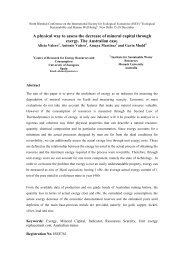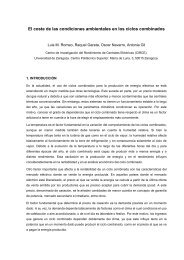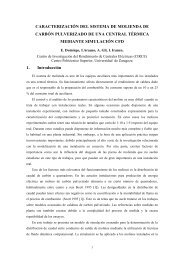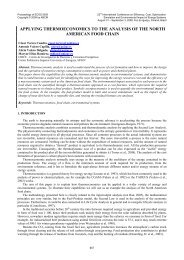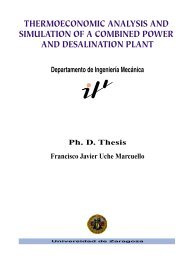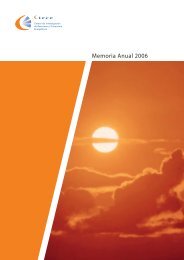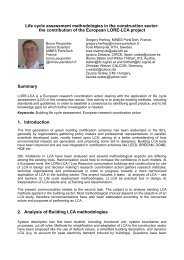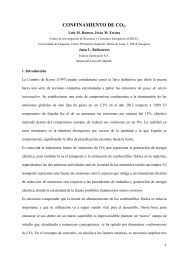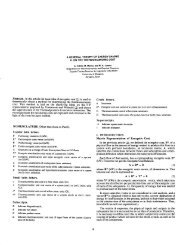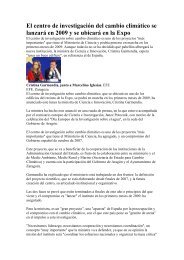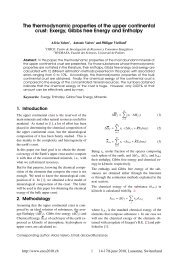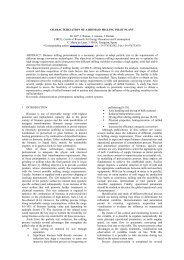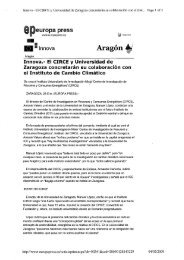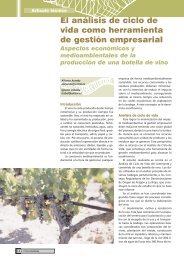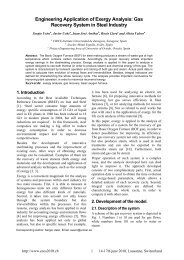Exergy evolution of the mineral capital on earth - circe
Exergy evolution of the mineral capital on earth - circe
Exergy evolution of the mineral capital on earth - circe
Create successful ePaper yourself
Turn your PDF publications into a flip-book with our unique Google optimized e-Paper software.
8 STARTING POINT, OBJECTIVES AND SCOPE<br />
Georgescu-Roegen was <strong>on</strong>e <str<strong>on</strong>g>of</str<strong>on</strong>g> <str<strong>on</strong>g>the</str<strong>on</strong>g> first authors in realizing <str<strong>on</strong>g>the</str<strong>on</strong>g> links between <str<strong>on</strong>g>the</str<strong>on</strong>g><br />
ec<strong>on</strong>omic process and <str<strong>on</strong>g>the</str<strong>on</strong>g> sec<strong>on</strong>d law <str<strong>on</strong>g>of</str<strong>on</strong>g> <str<strong>on</strong>g>the</str<strong>on</strong>g>rmodynamics. In his seminal work The<br />
Entropy Law and <str<strong>on</strong>g>the</str<strong>on</strong>g> Ec<strong>on</strong>omic Process [111], he states that “<str<strong>on</strong>g>the</str<strong>on</strong>g> entropy law itself<br />
emerges as <str<strong>on</strong>g>the</str<strong>on</strong>g> most ec<strong>on</strong>omic in nature <str<strong>on</strong>g>of</str<strong>on</strong>g> all natural laws [...] and this law is <str<strong>on</strong>g>the</str<strong>on</strong>g><br />
basis <str<strong>on</strong>g>of</str<strong>on</strong>g> <str<strong>on</strong>g>the</str<strong>on</strong>g> ec<strong>on</strong>omy <str<strong>on</strong>g>of</str<strong>on</strong>g> life at all levels”. Georgescu-Roegen stresses <str<strong>on</strong>g>the</str<strong>on</strong>g> importance<br />
<str<strong>on</strong>g>of</str<strong>on</strong>g> <str<strong>on</strong>g>the</str<strong>on</strong>g> variable time in ec<strong>on</strong>omic activity, which is clearly shown in <str<strong>on</strong>g>the</str<strong>on</strong>g> irreversibility<br />
<str<strong>on</strong>g>of</str<strong>on</strong>g> <str<strong>on</strong>g>the</str<strong>on</strong>g> exploitati<strong>on</strong> <str<strong>on</strong>g>of</str<strong>on</strong>g> resources. This author even postulated <str<strong>on</strong>g>the</str<strong>on</strong>g> Fourth Law <str<strong>on</strong>g>of</str<strong>on</strong>g> Thermodynamics,<br />
<str<strong>on</strong>g>the</str<strong>on</strong>g> entropy law <str<strong>on</strong>g>of</str<strong>on</strong>g> matter. According to this law, matter and not energy<br />
is <str<strong>on</strong>g>the</str<strong>on</strong>g> limiting factor in ec<strong>on</strong>omic growth. Georgescu-Roegen’s Fourth Law has been<br />
criticized by a number <str<strong>on</strong>g>of</str<strong>on</strong>g> analysts in ec<strong>on</strong>omics and physical sciences. It has been<br />
pointed out that <strong>on</strong> a fundamental physical level, <str<strong>on</strong>g>the</str<strong>on</strong>g>re is no such law. In principle,<br />
it is always possible to use high quality energy to trace, collect and reassemble <str<strong>on</strong>g>the</str<strong>on</strong>g><br />
dissipated elements [59]. The <str<strong>on</strong>g>the</str<strong>on</strong>g>oretical flaws <str<strong>on</strong>g>of</str<strong>on</strong>g> <str<strong>on</strong>g>the</str<strong>on</strong>g> Fourth Law, have lead some<br />
to dismiss Georgescu-Roegen’s ideas or deny <str<strong>on</strong>g>the</str<strong>on</strong>g>ir significance.<br />
Faber et al. [92] developed a model integrating <str<strong>on</strong>g>the</str<strong>on</strong>g>rmodynamic c<strong>on</strong>siderati<strong>on</strong>s into<br />
a model <str<strong>on</strong>g>of</str<strong>on</strong>g> optimal resource use and envir<strong>on</strong>mental management. They analyzed <str<strong>on</strong>g>the</str<strong>on</strong>g><br />
relati<strong>on</strong>ship am<strong>on</strong>g resource use in <str<strong>on</strong>g>the</str<strong>on</strong>g> ec<strong>on</strong>omic system, <str<strong>on</strong>g>capital</str<strong>on</strong>g> formati<strong>on</strong>, resource<br />
c<strong>on</strong>centrati<strong>on</strong> and entropy producti<strong>on</strong>.<br />
Ayres and Nair [17] state that <str<strong>on</strong>g>the</str<strong>on</strong>g> sec<strong>on</strong>d law <str<strong>on</strong>g>of</str<strong>on</strong>g> <str<strong>on</strong>g>the</str<strong>on</strong>g>rmodynamics has certain c<strong>on</strong>sequences<br />
for <str<strong>on</strong>g>the</str<strong>on</strong>g> producti<strong>on</strong> process which are not adequately reflected in <str<strong>on</strong>g>the</str<strong>on</strong>g> standard<br />
ec<strong>on</strong>omic model. Am<strong>on</strong>g <str<strong>on</strong>g>the</str<strong>on</strong>g>se c<strong>on</strong>sequences are that <str<strong>on</strong>g>the</str<strong>on</strong>g> exergy <str<strong>on</strong>g>of</str<strong>on</strong>g> <str<strong>on</strong>g>the</str<strong>on</strong>g> total<br />
output <str<strong>on</strong>g>of</str<strong>on</strong>g> a sector must be less than <str<strong>on</strong>g>the</str<strong>on</strong>g> exergy <str<strong>on</strong>g>of</str<strong>on</strong>g> <str<strong>on</strong>g>the</str<strong>on</strong>g> inputs and overall entropy<br />
is increased through <str<strong>on</strong>g>the</str<strong>on</strong>g> producti<strong>on</strong> <str<strong>on</strong>g>of</str<strong>on</strong>g> waste materials and heat. Ayres and Miller<br />
[16] developed a model that treats natural resources, physical <str<strong>on</strong>g>capital</str<strong>on</strong>g> and knowledge<br />
(measured in terms <str<strong>on</strong>g>of</str<strong>on</strong>g> negative entropy or negentropy) as mutually substitutable<br />
inputs into <str<strong>on</strong>g>the</str<strong>on</strong>g> producti<strong>on</strong> process. In 1988, Ayres [13] used <str<strong>on</strong>g>the</str<strong>on</strong>g> model for<br />
<str<strong>on</strong>g>the</str<strong>on</strong>g> calculati<strong>on</strong> <str<strong>on</strong>g>of</str<strong>on</strong>g> optimal investment policies and simulati<strong>on</strong> <str<strong>on</strong>g>of</str<strong>on</strong>g> optimal time paths<br />
and substituti<strong>on</strong> pattern for <str<strong>on</strong>g>the</str<strong>on</strong>g> world primary energy sources from <str<strong>on</strong>g>the</str<strong>on</strong>g> year 1869<br />
to 2050. Recently, Ayres [15], calculated <str<strong>on</strong>g>the</str<strong>on</strong>g> exergy performed in <str<strong>on</strong>g>the</str<strong>on</strong>g> US ec<strong>on</strong>omy<br />
during <str<strong>on</strong>g>the</str<strong>on</strong>g> twentieth century. One <str<strong>on</strong>g>of</str<strong>on</strong>g> <str<strong>on</strong>g>the</str<strong>on</strong>g> c<strong>on</strong>clusi<strong>on</strong>s <str<strong>on</strong>g>of</str<strong>on</strong>g> his study was that growth in<br />
exergy c<strong>on</strong>sumpti<strong>on</strong> have had an enormous impact <strong>on</strong> past ec<strong>on</strong>omic growth. The<br />
increasing efficiency <str<strong>on</strong>g>of</str<strong>on</strong>g> <str<strong>on</strong>g>the</str<strong>on</strong>g> producti<strong>on</strong> in primary work tended to result in lower<br />
costs, which triggered increasing demand that <str<strong>on</strong>g>of</str<strong>on</strong>g>ten resulted in greater exergy c<strong>on</strong>sumpti<strong>on</strong>.<br />
This fact is known as “Jev<strong>on</strong>s paradox”.<br />
Ruth [294] stated that use in ec<strong>on</strong>omic producti<strong>on</strong> processes must c<strong>on</strong>sider <str<strong>on</strong>g>the</str<strong>on</strong>g>rmodynamic<br />
limits <strong>on</strong> material and energy use in order to be optimal in <str<strong>on</strong>g>the</str<strong>on</strong>g> l<strong>on</strong>g-run.<br />
And ec<strong>on</strong>omic decisi<strong>on</strong>s must c<strong>on</strong>sider <str<strong>on</strong>g>the</str<strong>on</strong>g> finiteness <str<strong>on</strong>g>of</str<strong>on</strong>g> <str<strong>on</strong>g>the</str<strong>on</strong>g> resources available, <str<strong>on</strong>g>the</str<strong>on</strong>g><br />
interc<strong>on</strong>nectedness <str<strong>on</strong>g>of</str<strong>on</strong>g> <str<strong>on</strong>g>the</str<strong>on</strong>g> ec<strong>on</strong>omic system with o<str<strong>on</strong>g>the</str<strong>on</strong>g>r ecosystem comp<strong>on</strong>ents, <str<strong>on</strong>g>the</str<strong>on</strong>g><br />
time preference <str<strong>on</strong>g>of</str<strong>on</strong>g> c<strong>on</strong>sumers and producers and <str<strong>on</strong>g>the</str<strong>on</strong>g> technologies with which materials<br />
and energy are transformed in <str<strong>on</strong>g>the</str<strong>on</strong>g> producti<strong>on</strong> process. He developed a model<br />
<str<strong>on</strong>g>of</str<strong>on</strong>g> n<strong>on</strong>renewable resource use. As an example, Ruth determined <str<strong>on</strong>g>the</str<strong>on</strong>g> optimal extracti<strong>on</strong><br />
path and producti<strong>on</strong> <str<strong>on</strong>g>of</str<strong>on</strong>g> ir<strong>on</strong> ore at each period <str<strong>on</strong>g>of</str<strong>on</strong>g> time, taking into account<br />
<str<strong>on</strong>g>the</str<strong>on</strong>g>rmodynamic limits <strong>on</strong> material and energy efficiency, <str<strong>on</strong>g>the</str<strong>on</strong>g> treatment <str<strong>on</strong>g>of</str<strong>on</strong>g> endoge-



